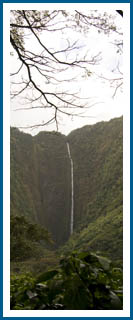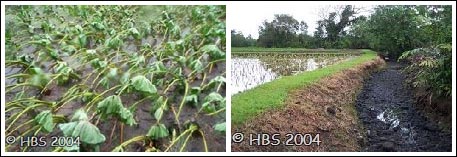
 |
 |
Field Updates: March 2004 Scientist Account (by Ron Englund)News Flash!
When we attempted to drive across Hi'lawe Stream at 8:00 am that morning we found a raging, chocolate colored river full of large tree branches floating by at very fast speed. We were trapped, as the river was far too high to drive even the biggest four-wheel drive across, and this road is the only way out of Waipi'o Valley. However, that was just the beginning of the rain! The rainfall continued to intensify but there was little we could do except as the road in both directions was now a raging torrent. Most devastated were the Waipi'o Valley taro farmers as they have a badly damaged crop that will be hurt by the cold mountain rainwaters and many plants were destroyed by physical effects of the floodwaters. The flood waters also completely scoured the stream channel, and now the 'auwai or channels to irrigate the taro field are in many places 6 ft above the stream where the water must come from. This means that there will be no water that is required for taro growing until the farmers can repair their irrigation system. 
How will this flood affect native stream animals and the stream? The stream channel has changed drastically since the students left Friday, March 12th. Large boulders have come down from the mountain, and slow-water pools have turned into fast-water riffles. Expect a very different looking stream next time you come to Hi'ilawe! Native animals are highly adapted to this type of flooding and will be just fine, as they have evolved to live in highly changeable streams. One beneficial aspect is that the alien species have less tolerance for flooding and can get swept out to sea. In fact, Ron and David saw many introduced green swordtail fish stranded on the roads right after the flooding, but we saw no native fish even though we know the streams contain many native 'o'opu (fish). The flood will benefit native stream species because the green swordtail fish carry many harmful parasites and eat young native 'o'opu and native insects. |
|
| Copyright © Hawaii Biological Survey, Bishop Museum Site last updated January 2010 |
||